Jeremy Miller's Blog, page 21
June 26, 2018
Homeostasis Inhibits Your Company’s Ability to Grow

All organisms are resistant to change. It’s not that they don’t like change or want change. Rather, it’s they are programmed to maintain a state of equilibrium. This is called homeostasis.
Your body, by design, maintains a steady temperature and other vital conditions like water, salt, sugar, protein, fat, and oxygen. This equilibrium is integral to your survival and success.
For example, the average body temperature of adults is between 97°F (36.1°C) to 99°F (37.2°C). Your body self regulates to maintain this state of equilibrium, but imagine how disruptive it would be to your life if you had to manually maintain a normal body temperature.
Homeostasis is a very good thing, unless you want to make a change.
That’s why dieting can seem like a yo-yo. According to multiple studies, 95% of people who diet to lose weight regain it within a few months. This is the tyranny of homeostasis. Your body desires equilibrium more than you desire a beach body.
Organizations also suffer from homeostasis. Growth strategies are often derailed by an organization’s unstated desire to maintain equilibrium.
Your company has the systems, culture, and talent required to maintain the status quo — where you are right now:
Growth rate
Market positioning and brand
Level of innovation
Employee satisfaction, turnover and retention
Profitability
If you look at the past three years of data, you will find there is a state of equilibrium in your business. A good place to see this is in your sales performance metrics:
Average number of new sales per month
Average size sale
Customer churn
When you examine a three year block of sales performance data you start to see a rhythm. This is your company’s equilibrium.
Homeostasis only becomes a problem when you want to change. You have to build the habits and organizational capacity for the next level to get to the next level.
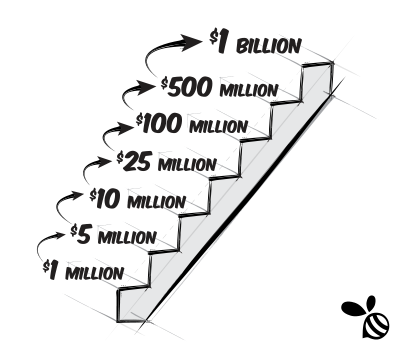 Companies have predictable revenue plateaus: $1 million, $5 million, $10 million, $25 million, $100 million, and so on. Each plateau involves a major shift for the business. It requires different skills, management resources, talent, and systems to break through the plateau and reach the next level.
Companies have predictable revenue plateaus: $1 million, $5 million, $10 million, $25 million, $100 million, and so on. Each plateau involves a major shift for the business. It requires different skills, management resources, talent, and systems to break through the plateau and reach the next level.
The Achilles’ heel to breaking through these plateaus is people. My mentor and friend, Jim Stewart, taught me, “A business’s ability to grow is dependent on the entrepreneur’s ability to change.”
Growth strategies derail when the entrepreneur, owner, CEO, or leader is unable to change to meet the requirements of the next plateau. For example, the CEO of a $10 million business has the leadership skills and habits to run a $10 million business. If he cannot develop the leadership habits to operate a $25 million business, the company won’t be able to break the $25 million revenue plateau.
No matter how good the strategy, a CEO’s inability to evolve will derail the company’s growth strategies.
It’s very difficult to overcome homeostasis internally, because you often can’t see or feel the systems and habits that are holding you and your team back. This is a big part of the consulting work I do with clients. I help ambitious teams grow their businesses and brands to the next level.
Working with dozens of clients over the years, I have found overcoming homeostasis requires a multi-pronged attack:
Growth Strategy: Clear thinking drives results. The first step is to clearly define the branding and growth strategy for the business.
Strategy Implementation: Strategy implementation is often misunderstood, because leadership teams build their plans around projects, tasks, and other investments that they deem as priorities to grow the business. The reality is strategy implementation is primarily about creating the organizational capacity to operate at the next level.
Leadership Coaching: Leadership coaching is the best offense to overcoming homeostasis. When you develop the leadership capacity of the CEO and the management team, you greatly improve your prospects of achieving your growth objectives.
The 3 pronged attack is effective, because it empowers the team to work on the business and create the organizational capacity to operate at the next level.
The results are exciting. The current average growth rate of my clients is 27.4%.
If you’re facing homeostasis or working to grow your business to the next level, I’d welcome a conversation. Here’s a link to my calendar. Let’s schedule a time to chat.
You're reading Homeostasis Inhibits Your Company’s Ability to Grow by Jeremy Miller, originally posted on Sticky Branding. Did you enjoy this article? If so, sign-up for more of Jeremy's articles at Sticky Branding.
June 19, 2018
How IKEA Names Its Products: It’s a Surprisingly Brilliant Naming System

IKEA products stand out with their quirky brand names:
Docksta table
Ektorp sofa
Poäng armchair
Kallax shelving units
Billy bookcase
Each name elevates the perceived value of the object, and signals it has a distinct place in your home.
How IKEA names its products is ingenious. The naming system was created by Ingvar Kamprad, IKEA’s founder. Kamprad struggled with dyslexia, and he had trouble remembering the order of the numbers in item codes. So he swapped the numbers for names. This made it easier for him to remember each item, and as a result he made fewer mistakes when filling out forms.
The naming system is brilliant in its simplicity and scalability. Each product is named after Swedish towns and villages, humans, and other applicable Swedish words.
The system is even cooler than simply assigning random Swedish words to products. Each category of products is assigned a specific type of name. For example, outdoor furniture is named after Scandinavian islands:
Äpplarö are wooden patio furniture
Solleron are outdoor sofas
Mastholmen are outdoor coffee tables
If you study Google Maps, you can find each island that the product represents.

To simplify its inventory and branding, IKEA uses the same product name for each of its products in all its markets. A Fartyg ceiling light is a Fartyg no matter where you buy it.
breaks down the naming system:
Bathroom items: Names of Swedish lakes and bodies of water
Linens: Flowers and plants
Bedroom and Living Room Furniture: Norwegian places
Bookcases: Professions and Scandinavian boy’s names
Bowls and Vases: Swedish place names, adjectives, spices, herbs, fruits, and berries
Boxes, Pictures, and Wall Decorations: Swedish slang expressions and Swedish place names
Children’s Products: Mammals, birds, adjectives
Desks and Chairs: Scandinavian boy’s names
Fabrics and Curtains: Scandinavian girl’s names
Outdoor Furniture: Scandinavian islands
Kitchen Accessories: Fish, mushrooms and adjectives
Lighting: Units of measurement, seasons, months, days, shipping and nautical terms, Swedish place names
Rugs: Danish place names
Sofas, Chairs and Dining Sets: Swedish place names
The system helps IKEA name new products quickly and efficiently, but IKEA doesn’t constrain itself by the system. They’ll break their own rules when it makes sense.
 For instance, the Billy bookcase, IKEA’s #1 selling product, is named after an employee, Billy Likjedhal. Some products have functional names, because they work better:
For instance, the Billy bookcase, IKEA’s #1 selling product, is named after an employee, Billy Likjedhal. Some products have functional names, because they work better:
The Sladda bicycle translates to “skid” in Swedish.
The Krossa spice mill means to crush or grind.
With over 12,000 products, IKEA has created a brilliant naming system. The names are quirky and endearing, and they elevate the status of each product. The naming system is efficient and scalable, which is essential for a global brand that is naming thousands of unique products.
You're reading by Jeremy Miller, originally posted on Sticky Branding. Did you enjoy this article? If so, sign-up for more of Jeremy's articles at Sticky Branding.
June 12, 2018
The Secret Sauce to Writing Memorable Marketing Copy
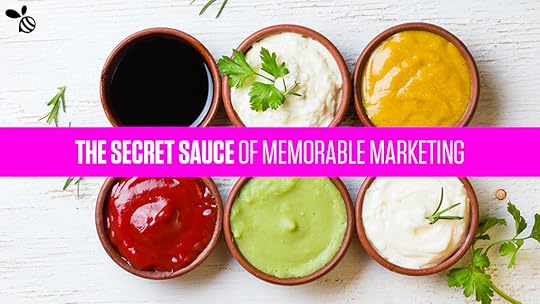
Puffy words dilute the effectiveness of your marketing.
Companies are always striving to make their products and services stand out so they puff up their marketing copy with words like,
Innovative
Premium quality
Customer oriented
State of the art
World class
These words sound good, but they lack meaning. Consider these three automotive slogans that are based on the word innovation:
“A tradition of innovation.”
“Driving American innovation.”
“Innovation that excites.”
Do you know what brands each slogan is associated with? No? I’ll give you a hint. Firestone, Ford, and Nissan — in that order.
(Sadly, I had to deliberately memorize this analogy for my keynote speaking, because I couldn’t remember the slogans even after using them dozens of times.)
Puffy words may look good on paper, and they may even feel good to say. But these words lack meaning. There’s nothing to anchor the word “innovation” in your mind. As a result, each slogan is completely forgettable.
The Secret Sauce to Memorable Marketing Copy
A group of researchers at Cornell University conducted a study on memorability. They wanted to know what makes phrases and quotes stick in your mind.
To answer the question the researchers studied over 1,000 movie quotes in IMDB dating back to 1967. Quotes like,
“May the Force be with you.”
“Here’s looking at you, kid.”
“I’m going to make him an offer he can’t refuse.”
The study cracked the code of memorable quotes, and the lessons apply equally to marketing copy. Memorable phrases possess three traits:
A pearl of wisdom. There’s a concrete message or idea to be conveyed.
Unique combination of words. The idea sticks because it’s expressed in a unique way.
Ordinary sentence structure. There’s no magic to the copywriting. Memorable phrases tend to use very ordinary grammatical structures.
The takeaway I pulled from the research is to focus on the idea. Too much time gets invested in puffing up and over inflating features and benefits of a product, versus simply articulating what your brand delivers.
Memorable Marketing Relies on Concrete Words
Memorable marketing is based on “concrete words.” These are words or phrases that stimulate visual images in your mind. These words are far easier to understand and remember than abstract words like “innovation” or “revolutionary.”
For example, for over 50 years M&M’s have told us the candy, “Melts in your mouth, not in your hands.” There are no abstract words in this statement. It’s clear, succinct, and direct. You may not know what the candy tastes like, but you know it won’t make your hands messy when you eat it.
Under Steve Jobs, Apple did a remarkable job clearly articulating the value proposition of new technologies with concrete words:
iPod offered “a thousand songs in your pocket.”
iPhone provided “the first touchscreen smartphone.”
iPad was a “tablet computer.”
In the launch of the first iPhone in 2007 Steve Jobs said, “An iPod, a phone, and an internet mobile communicator. These are not three separate devices! This is one device. And we are calling it iPhone! Today Apple is going to reinvent the phone. And here it is.”
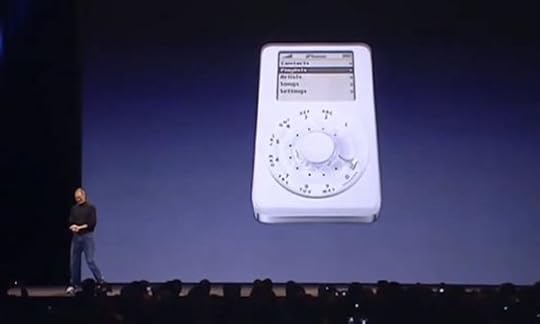
What made this introduction so effective is Steve Jobs used concrete words that everyone understood:
iPod
Phone
Internet
Perfect the Idea Before the Words
Memorable marketing copy is based on conveying a pearl of wisdom, and this is the hardest part of branding.
Distilling your brand into a singular, core idea is easier said than done. As a result, marketers gravitate towards the easier yet less effective option: adding puffy copy to differentiate a weakly positioned brand.
The first step to creating memorable marketing copy is to distill the idea. What is that pearl of wisdom you want to convey to prospects and customers?
Once you understand the core idea of your brand, it becomes a lot easier to express it in a compelling way that’s hard to forget.
You're reading The Secret Sauce to Writing Memorable Marketing Copy by Jeremy Miller, originally posted on Sticky Branding. Did you enjoy this article? If so, sign-up for more of Jeremy's articles at Sticky Branding.
June 6, 2018
The Myth of Mobile First, Especially for B2B Brands

52.2% of all website traffic was generated through mobile devices in 2018, according to Statistica. This is up dramatically. In 2015 mobile traffic accounted for 35.1%, and in 2012 it was a paltry 10.7%.
 Marketers look at these stats and loudly proclaim, “Mobile First!”
Marketers look at these stats and loudly proclaim, “Mobile First!”
They argue that companies have to design websites, content, and marketing campaigns for mobile devices first. The assumption is, “No one uses their desktop and laptop computers to surf the web anymore.”
But before you dive onto the mobile first bandwagon, let’s challenge the numbers. Your customer may not be as mobile dependent as the 52.2% statistic indicates.
Not All Markets Are Mobile First
 The global average is 52.2%, but the number swings widely depending on what country you consider.
The global average is 52.2%, but the number swings widely depending on what country you consider.
Statistica shares mobile website traffic by region. As of April 2018, 65.2% of all web traffic in Asia was on mobile devices, and it was 63.9% in Africa.
In North America, 39.6% of website traffic is conducted on mobile, and it’s 37.4% in Europe.
This is a huge gap! While mobile is incredibly important, it’s not as dominant as the stats may indicate, at least in North America and Europe.
B2B Buyers Surf During the Day
The mobile first premise skews even further for B2B brands.
Consider your day-to-day activities. How much time do you spend at the office searching professional sites from your phone?
The average office worker is affixed to their desktop or laptop computer for most of the day. They use their PC for a variety of applications: email, presentations, documentation, video conference calls, programming, or accessing business applications.
Office workers do use their mobile devices a lot, but are they researching and making buying decisions for B2B products from their phones?
A good exercise to answer this question is to dig into your Google Analytics for the past 12 months:
What percentage of users accessed your site from a mobile or tablet device?
What time of day are visitors frequenting your website?
Many B2B brands are surprised to see 80% or more of their website traffic is originating on desktop computers between 9am and 5pm.
You Can’t Ignore Mobile
Your customers may not be engaging with your brand on mobile first, but that doesn’t mean you can ignore mobile either.
On March 26, 2018, Google officially announced that they are using mobile first indexing. Google explains, “Our crawling, indexing, and ranking systems have typically used the desktop version of a page’s content … Mobile-first indexing means that we’ll use the mobile version of the page for indexing and ranking, to better help our – primarily mobile – users find what they’re looking for.”
Google is operating from a mobile first premise, which means if you want your website to rank high in Google’s search results then you better have a great mobile site.
Customers are also evaluating your brand across multiple screens. For B2B brands, your customers may spend the bulk of their time looking at your website from a desktop computer, but that doesn’t mean they won’t look you up from their phone or tablet too.
Avoid Simplistic Proclamations
The big problem with proclaiming a “mobile first strategy” is it ignores the complexity of the situation.
Yes, mobile is important. Google tells you so. But that doesn’t mean your customers are actually buying your products and services from their phones.
Build your marketing strategy in context:
What do your expect?
How do they interact with your brand?
How can you deliver exceptional buying experiences?
You're reading The Myth of Mobile First, Especially for B2B Brands by Jeremy Miller, originally posted on Sticky Branding. Did you enjoy this article? If so, sign-up for more of Jeremy's articles at Sticky Branding.
May 29, 2018
How the Frisbee Got Its Brand Name

The Frisbee is an iconic brand launched out of the ashes of one of the biggest toy fads in history.
After selling more than 100 million Hula Hoops in 16 months, Arthur “Spud” Melin and Rich Knerr were flat broke.
 The Hula Hoop was an international sensation. Children and adults alike were captivated with twisting a plastic ring around their hips.
The Hula Hoop was an international sensation. Children and adults alike were captivated with twisting a plastic ring around their hips.
For the life of me, I cannot see why the Hula Hoop became a fad, but it was a different time. It was 1958, and kids weren’t distracted by video games, Netflix, electronic devices, and helicopter parents managing their every moment.
As quickly as the Hula Hoop fad took off, it collapsed. This caught Melin and Knerr off guard. They thought they’d created a new sport, and they had set up factories to produce millions of Hula Hoops. Their ambitions didn’t keep up with demand, and soon they had a massive surplus that robbed them of profits.
Wham-O, their company, completed 1958 with a $10,000 loss.
For me this is where the story gets interesting. Melin and Knerr shrugged off the loss! They recognized success can come and go, but to be successful entrepreneurs they’d have to find something new.
In a very short order Wham-O released several new toys:
1958, Frisbee
1961, Slip ‘N’ Slide
1965, Super Ball
Each of these toys became iconic brands, but let’s take a look at the Frisbee because it saved the company.
Prior to the launch of the Hula Hoop, Wham-O acquired the rights to the Frisbee from Walter “Fred” Morrison. Morrison called his toy the Pluto Platter. It was a flimsy plastic disc that wobbled in the air. It kind of looked like a UFO or flying saucer when thrown.
Shortly after buying the rights to the Pluto Platter, Wham-O changed its name to the Frisbee. Morrison hated it. He said, “I thought Frisbee was a terrible name. I thought it was insane.”
But Knerr demonstrated his marketing genius. “Frisbie” was the name kids were calling the product.
Frisbee’s name is based on Frisbie Pie Co., a long gone Connecticut baker. Back in the forties, college kids liked to toss empty pie tins around for fun — again, a different time before we had iPhones and Netflix. As the kids were introduced to the Pluto Platter they started calling it a “frisbie” after the pie plates.
When Knerr was evaluating the Pluto Platter, he heard the kids referring to it as Frisbie. He embraced the nickname, and adjusted the spelling to Frisbee.
 Morrison wasn’t a fan. He had gravitated towards the traditional naming conventions. Initially he called his invention the “Whirlo-Way.” This was a tribute to Whirlaway, the horse that won the Triple Crown in 1941.
Morrison wasn’t a fan. He had gravitated towards the traditional naming conventions. Initially he called his invention the “Whirlo-Way.” This was a tribute to Whirlaway, the horse that won the Triple Crown in 1941.
Following the reports of spacecraft over Roswell, New Mexico in 1947, Morrison jumped on the UFO bandwagon. He called his discs “Flying Saucers” and then “Pluto Platters.”
Thank goodness for Knerr. It was a stroke of genius. He embraced his market, and used the customer’s slang over cheesy, made-up product names.
The Frisbee is passing it’s 60th anniversary. It’s remarkable to think how far this brand has gone. Frisbee is now a like Kleenex or Xerox. And Morrison is still collecting royalty checks off the name, even though he hated it. He said, “It just goes to show I am a bad judge of names.”
You're reading by Jeremy Miller, originally posted on Sticky Branding. Did you enjoy this article? If so, sign-up for more of Jeremy's articles at Sticky Branding.
May 22, 2018
3 Metrics to Manage Brand Performance

Sales performance is the #1 indicator of a brand’s success in small- to mid-sized companies, and you can see it in your data:
More customer demand
Higher profits
Lower competition
Your sales metrics are an effective measure of brand performance. Sure, you can look at other metrics like social media engagement or the number of visitors to your website, but all those metrics roll up to one big question. Is marketing moving the sales needle?
I’m not interested in the soft, squishy side of marketing. I want to see branding and marketing strategies that clearly drive sales results.
The 3V’s of Brand Performance
In Sticky Branding (the book), I talked about the 3V’s of Brand Performance:
Volume: Demand for your products and services.
Velocity: The speed a customer travels through the buying process.
Value: The ability to sell at a premium and avoid discounting.
Volume, Velocity, and Value are three core metrics I examine to evaluate a brand’s performance, because they translate into clear, tangible business results:
Revenue
Profit
Sustainability
The challenge then is how to pull out the data to examine the 3V’s in your business.
Volume: What Is the Demand for your Products and Services?
Volume is a simple metric to capture. It’s demand. How many inquiries or sales leads does your business generate per month?
Volume is a relatively easy metric to track, but it’s hard to move.
Adam Morgan demonstrates in Eating the Big Fish that a brand leader — a company that dominates a category — makes triple the profit of a number two brand. A number-three brand makes half the profit of a number-two.
He says, “If profit allows a company to make choices, to invest resources in finding sources of future competitive advantage, then this disparity serves to widen the discrepancy between the chips the Brand Leader has at its disposal and the pile we have to play with.”
The gap between #1, #2, #3 and everyone else is immense, and this is why generating demand and brand awareness can be so tricky. The odds can be stacked against your brand, and you have to market more aggressively and effectively than the competition to stand out and move the sales needle.
Velocity: How Quickly Do Customers Buy?
Fast, efficient selling demonstrates several aspects of brand performance:
Clarity: Your brand messaging is clear and your customers get it, want it, and self-select.
Desire: Your customers have lots of options, but they choose your brand first.
Process: Your website, marketing materials, and salespeople are aligned. Your brand gives customers everything they need when they need it to make efficient buying decisions.
Tracking sales velocity requires some research and discipline:
Plot the Buyer’s Journey: Document how your customers move through the buyer’s journey from awareness to consideration, decision, implementation, and application.
CRM Tracking: Configure your CRM system to track key milestones in the buyer’s journey, and measure the amount of time it takes a customer to move through the cycle.
Once you have time measurements you can look for ways to optimize the buyer’s journey. What can you do to make it easier for your customers to buy?
My holy grail for a brand is the Two Call Close. This is the ability to sell big deals ($10,000 to $75,000) in two calls over two weeks. This is fast, efficient selling that requires polishing your brand into a finely tuned machine.
Value: How Often Does Your Team Discount to Win?
How often does your company have to discount and leave money on the table to win?
A strong brand is price resistant. Customers understand the value of your services, and choose it first. They expect the service to be fair market value, but they don’t expect it to be the cheapest.
Growing a strong brand is your company’s primary line of defense. It’s likes building a moat around a castle that insulates and protects your products and services in measurable ways:
Increased perceived value and affinity towards your products and services.
Increased customer attraction and retention. Your customers seek out your brand, and come back frequently.
Decreased price sensitivity, because your clients choose you first and gravitate towards your brand.
The moat gets deeper and wider the stronger your brand becomes.
A simple metric to monitor Value is discounting. In your CRM or accounting system track discounts:
How much money is discounted per transaction?
How much money is lost to discounting per month?
Frequent discounting is the canary in the coal mine for brand challenges. If your brand is relying on discounting to win, it’s selling on price versus value.
Follow the Trend Lines
The 3V’s are a powerful set of metrics, but their true value is realized when you monitor them over time:
How are they changing month-to-month and quarter-to-quarter?
What strategies, actions, or market forces influence your metrics?
How can you get better?
There is no shortage of metrics to manage your business, but the 3V’s will help you quantify and demonstrate brand performance. They help you see how your brand is moving the sales needle, and indicate where your brand is succeeding and where it may be falling behind.
You're reading 3 Metrics to Manage Brand Performance by Jeremy Miller, originally posted on Sticky Branding. Did you enjoy this article? If so, sign-up for more of Jeremy's articles at Sticky Branding.
May 15, 2018
How 3 Common Household Items Got their Names

Brand names are pervasive. You use products daily, and often don’t even pay attention to the branding. They’re just things you own, and things you rely on.
For example, you’ll reach for a can of WD-40 to loosen a rusty bolt. Open the refrigerator and you probably have a box of Arm & Hammer baking soda tucked away. Every time you pair two electronic devices you’re using Bluetooth.
These brands are everywhere, but their brand names also have interesting origin stories.
WD-40
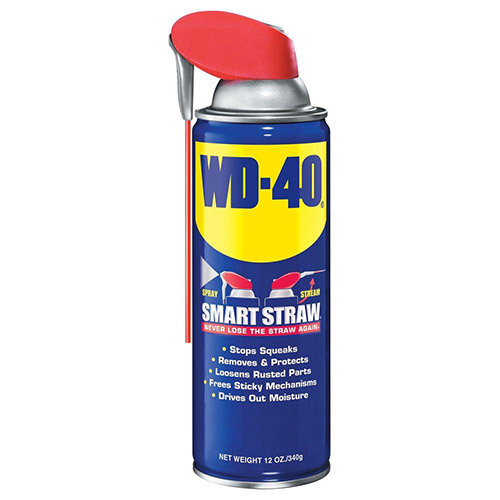 WD-40 is wondrous. It loosens bolts, silences squeaks, gets rid of rust, unsticks gum, cleans tiles, and removes goo. It’s like duct tape — no home should be without it.
WD-40 is wondrous. It loosens bolts, silences squeaks, gets rid of rust, unsticks gum, cleans tiles, and removes goo. It’s like duct tape — no home should be without it.
Invented in 1953, WD-40’s name is as functional as the product. It stands for “Water Displacement, 40th Formula.”
According to WD-40’s website, “In 1953, a fledgling company called Rocket Chemical Company and its staff of three set out to create a line of rust-prevention solvents and degreasers for use in the aerospace industry … it took them 40 attempts to get the water displacing formula worked out.”
Persistence paid off, and the name stuck.
Arm & Hammer
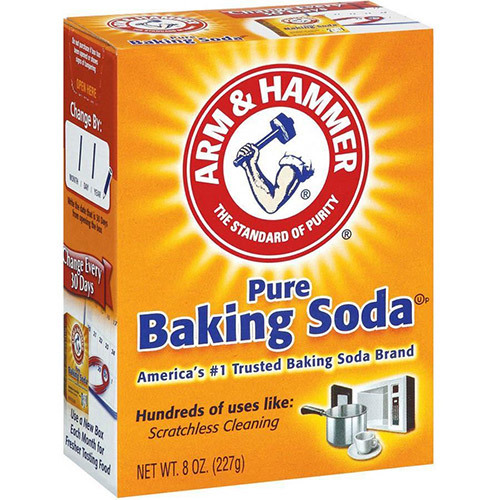 Arm & Hammer is the world’s largest baking soda brand, and its name is synonymous with the product.
Arm & Hammer is the world’s largest baking soda brand, and its name is synonymous with the product.
The name originated from a succession plan. In 1846, Dr. Austin Church and John Dwight began preparing bicarbonate of soda for commercial distribution. They built a thriving company. In 1867, Dr. Austin retired and his sons acquired the business.
The Arm & Hammer logo and name were brought over from Dr. Church’s youngest son’s company, Vulcan Spice Mills. Arm & Hammer symbolized the myth of Vulcan, the Roman god of fire, who would strike his mighty hammer on his anvil.
It was an effective brand, both in name and logo, and was adapted to the baking soda product line. Today the name is recognized as a symbol of baking soda around the world.
Bluetooth
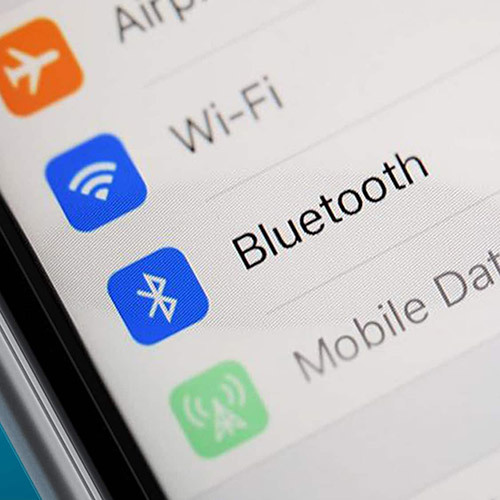 Along with WiFi, Bluetooth connected devices are ubiquitous in the modern home.
Along with WiFi, Bluetooth connected devices are ubiquitous in the modern home.
Bluetooth’s brand name has the tone of a modern tech startup. It’s a catchy word, but kind of meaningless. It looks like an invented word like Yahoo!, Yelp, or Hulu. Turns out there’s much more depth to Bluetooth than an invented word.
Bluetooth comes from the Viking king of Denmark between 958 and 970, Harald Blatand. His surname translates to “bluetooth.” Legend has it that King Blatand suffered from a dead tooth that was reported to have turned blue. Hence, the weird nickname.
The king was famous for uniting parts of Denmark and Norway into one nation. He was effective at establishing communications between two parties in a non-violent manner.
The story of King Blatand made for a powerful symbol for the Bluetooth brand. He was a role model for developing communication technologies, and getting disparate devices to talk with each other.
Take a Look Around
Take a look around your home and notice the volume of brand names that you interact with daily.
It’s really quite remarkable. Everything has a name. It’s the most fundamental building block of a brand.
As you look, notice the names that stand out. These are the kinds of names you want to strive to be like when you name a brand.
You're reading by Jeremy Miller, originally posted on Sticky Branding. Did you enjoy this article? If so, sign-up for more of Jeremy's articles at Sticky Branding.
May 8, 2018
Branding Is Multifactorial

Like so many other aspects of life, branding is easier said than done. It comes down to mastering a set of behaviors that are theoretically uncomplicated, but are also difficult to put into practice consistently.
For instance, I wrote in Branding Is Simple, “‘It’s the relationship, stupid.’ Strong brands form strong relationships with customers. It’s that simple. When your customers know your brand, like it, and trust it — they’ll choose it first.”
Building strong customer relationships is theoretically uncomplicated, but achieving the desired outcome is complicated. There are no silver bullets or simple paths, because the brand building process is multifactorial.
Simple Solutions Create Confusion
Too many complex problems are reduced into simple yet ineffective maxims.
Dieters, for instance, are told the key to lasting weight loss is to “Eat less. Move more.” That sounds simple enough, but the science proves otherwise. According to Jason Fung, author of the Obesity Code, 99% of diets fail. He argues convincingly that obesity is more than the amount of food you eat or the amount you exercise, it’s a multifactorial disease.
Fung writes, “Virtually all diseases of the human body are multifactorial. Consider cardiovascular disease. Family history, age, gender, smoking, high blood pressure and physical activity all influence, perhaps not equally, the development of heart disease.”
He continues, “There is no one single cause of obesity. Do calories cause obesity? Yes, partially. Do carbohydrates cause obesity? Yes, partially. Does fiber protect us from obesity? Yes, partially. Does insulin resistance cause obesity? Yes, partially. Does sugar cause obesity? Yes, partially. All these factors converge on several hormonal pathways that lead to weight gain.”
Jason Fung’s message on obesity is applicable to business. Complex challenges, like growing your brand, involve addressing multiple factors to achieve your desired outcome.
Simple answers to multifactorial problems are rarely going to give you the results that you want.
The Solution, It Depends
How do you grow a Sticky Brand? It depends.
As a business owner, I hate hearing “It depends.” I don’t want to pay for “audits” and “discovery calls” and other forms of naval gazing. I want solutions that deliver clear and tangible outcomes.
But as a leader, I have to be accountable. There are no silver bullets, simple maxims, and easy answers to growing my business. My team and I have to master a lot of little things to achieve our goals.
The solution to your branding goals depends on multiple factors: size of business, reputation, position in the marketplace, brand awareness, structure and effectiveness of your team, ability to iterate and change your business model, and financial resources.
Your solution is found in your strategic plan — how you will move your organization From X to Y by When. The levers you choose to pull will depend on your situation.
Where to Start with a Brand Strategy
Branding is theoretically uncomplicated, but the brand building process is multifactorial. I recommend starting with an exercise to tackle three big questions:
Where is your brand today, and where does it need to move towards?
What’s working, and what isn’t working?
Who here is part of the team moving forward, and who has stopped growing and cannot keep up?
When you embrace the complexity of your situation you can simplify your path forward, and be able to pull the levers that will have a measurable impact on your business.
You're reading Branding Is Multifactorial by Jeremy Miller, originally posted on Sticky Branding. Did you enjoy this article? If so, sign-up for more of Jeremy's articles at Sticky Branding.
May 1, 2018
Your Brand has a Shelf Life, and It’s Shorter than You Think

Every brand has a shelf life, and It’s getting shorter and shorter.
Every three to seven years your brand needs a tune up, depending on the industry. Technology brands, for instance, change faster and more frequently than industrial brands. Regardless of the industry, we all face the pressure to evolve our brands to remain relevant.
One of the most visible areas you can see the aging process is in your website. Corporate websites tend to need a visual overhaul every two to four years. In the third year they start to look tired, and by the fourth they look dilapidated.
Imagine what a dilapidated website says to customers about your brand?
Three Signs Your Website Is Past Its Due Date
There are three signs your website may be out of date:
Your website doesn’t look good on mobile devices. Having a responsive or mobile friendly website is critical. Not only are you driving away mobile users who cannot read your website, you’re driving away Google. Google penalizes websites that are not mobile friendly.
Slow website performance. Google ranks faster websites higher. If two sites offer similar content, Google favors the site with faster page load times. You can test your site’s performance at GTmetrix.
Your website looks old fashioned and out of date. Fashion and tastes change, and you can visually spot the layout of a website designed in 2018 versus 2014.
Any of these issues may initiate a website redesign project, but don’t stop there. This is your opportunity to reevaluate your brand and determine if your brand strategy and positioning are current too.
An Outdated Website Is a Symptom of an Outdated Brand
The challenge with a new website project is it’s just the tip of your branding problems.
As soon as you start updating the website plenty of other branding projects start to popup. It’s a little like home renovation. You start with your kitchen, and soon your renovating the whole house.
Website overhauls follow a predictable trajectory:
As you work on the site design you make some adjustments to your logo and visual identity.
That triggers redoing all of your letterhead and business cards.
Then you rewrite all the copy on your site with a refined value proposition and better stories.
That triggers redoing all your brochures and marketing collateral.
Then you look at the executive biographies and they need work too.
That triggers a photoshoot with more copywriting.
What started as a $15,000 to $20,000 project can quickly balloon into a $100,000 rebranding project.
Start with a Brand Audit: Where Are You Today?
Before diving into a website project, take an audit of your brand:
Where is your brand today?
What else needs to be updated?
Examine each customer touch point and evaluate its effectiveness:
Does it articulate your brand and value proposition effectively?
Does it present your brand in a unique and compelling way?
Does it drive prospects and customers to clear and logical next steps?
Doing an audit at the start of a major marketing project will save you a lot of heartache, scope creep, and budget overruns. It’s better to know what you’re getting into before you start.
All brands evolve because businesses evolve. It’s only logical to expect that your brand will need to be refreshed every three to seven years. Use your website as an early warning system, because an out of date website is a sign of an out of date brand.
You're reading Your Brand has a Shelf Life, and It’s Shorter than You Think by Jeremy Miller, originally posted on Sticky Branding. Did you enjoy this article? If so, sign-up for more of Jeremy's articles at Sticky Branding.
April 24, 2018
Branding Is Simple

Sometimes we need a quick reality check. Branding is simple.
There’s a tendency to make branding complicated, but it’s not. To paraphrase James Carville, “It’s the relationship, stupid.”
Strong brands form strong relationship with customers. It’s that simple. When your customers know your brand, like it, and trust it — they’ll choose it first.
If you get the relationship right, everything else gets so much easier.
Build Relationships Early and Often
The best time to start building a customer relationship is three years before they have a need for your products and services.
Three years may seem like a long time, especially if you have a short sales cycle, but building relationships goes beyond sales transactions.
Three years is a good time horizon, because getting customers to know your brand, like it, and trust it takes time. Think of your brand as a bank. Each positive customer interaction is a small deposit of trust.
Serving your customers well, generating reviews and buzz, and promoting your brand are all deposits in the trust bank.
Relationships Bring Customers Back
A brand isn’t sticky without repeat customers.
Winning a sales is great, but there’s something wrong if the customer doesn’t come back again and again.
Marketing hype scratches off quickly. Brands like can create controversy and publicity to generate awareness and get lots of one-time customers. But strong brands have substance. There’s more to them than great marketing.
Investing in customer relationships deliver two tangible benefits:
Higher customer loyalty. Customers are less likely to “kick the tires” and explore other options when they know, like, and trust your brand.
Lower customer acquisition costs. It’s less expensive to sell your products and services when your brand has deep customer relationships. These customers are fans. They refer often, and provide social proof.
Loyal customers and lower customer acquisitions costs are competitive advantages that you can take the bank.
Branding Is a Process
Building lasting relationships is a process that takes time and commitment, but it’s fundamental to branding.
When your customers know your brand, like it, and trust — they’ll choose it first.
Building strong customer relationships is easier said than done, but it starts with a choice. Do you want to sell to a customer once, or are you building a brand where your customers come back again and again?
I choose the latter.
You're reading Branding Is Simple by Jeremy Miller, originally posted on Sticky Branding. Did you enjoy this article? If so, sign-up for more of Jeremy's articles at Sticky Branding.



